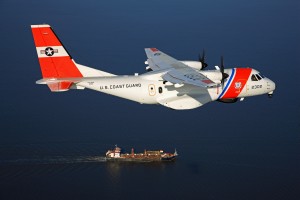2013-02-06 Recently, the USCG has ordered an additional aircraft to its Maritime Patrol aircraft fleet. This order will bring the fleet size to 18.
The role of the Ocean Sentry (the USCG’s version of the CN-235) is central to the USCG’s missions.

According to Captain Richard Kenin, then Commanding Officer of the USCG, Air Station, Miami, the Ocean Sentry is an important upgrade for their operations.
We need the loiter time this aircraft has. We really need the airplane that can stay out 7 or 8 hours and that is important for a number of different reasons.
First is that you can actually cover the ground that you need to.
Second, it takes a long time for the ship to get there. And we have problems in the past when I found the ship, but now I had to leave and now we lost it. And then by the time the ship or another asset comes, whether it would be CBP or another Coast Guard asset, it is difficult to find they are gone. And we play a lot of cat and mouse with smugglers in the Caribbean overseas, so it is important to be able to find these folks because they will try to dodge and hide until we are forced to leave.
An additional consideration for the USCG in the Caribbean and the Gulf of Mexico is that they are not alone. They are joined by Columbian and Mexican CN-235s, an additional 8 with more on the way.
For the USCG, their maritime patrol aircraft play a pivotal role in executing their missions.
The new MPA’s concept of operations is essential as well to the functioning of the 21st century USCG. The new MPAs are significant enablers for the legacy and modernized fleet. The best way to think about this is simply a simple Venn diagram in which the surface asset occupies one Venn circle, and the MPAs provide a second Venn circle significantly expanding the range of operation, and hence the ability to execute missions.
The con-ops typically depends on the mission and is essentially the same as the HC-130. Part of this calculation is the determination of proper track spacing (distance between search legs), which is a function of the size of the target (man in the water would require a very small track spacing for example), sea state, visibility, cloud cover, etc. Night searches are done if the target is thought to be capable of detection by radar, possess radio or signaling equipment.
Typically a ship would be controlling one or more MPA/helicopters and continuously updating which areas have been searched and the results. Of course this function can be done by a shore station as well. The primary purpose the ship is involved at all is to be available as a helo platform and/or to launch a boarding party, engage the target if hostile or to recover survivors.
However, the C-144 can do more than just pass target position information or provide vectors. It has the ability to take photos and download them. So the ship can have information on the number of people aboard the target craft (good to know if they are bad guys) and perhaps even information on arms.
https://sldinfo.com/shaping-a-21st-century-uscg-the-key-role-for-maritime-patrol-aircraft/
According to an Airbus Military press release (January 5, 2013):
The U.S. Coast Guard has exercised a contract option to purchase the service’s 18th HC- 144A Ocean Sentry Maritime Patrol Aircraft. The HC-144A is based on the Airbus Military CN235 tactical airlifter and is delivered by prime contractor EADS North America. More than 230 CN235 aircraft are currently being operated by 29 countries
“The HC-144A is becoming the Coast Guard’s primary maritime patrol aircraft, and we’re proud of the central role it is playing in executing the service’s increasingly demanding mission,” said Antonio Rodriguez-Barberan, Airbus Military Senior Vice President Commercial.
The option is part of a contract awarded in July 2010 for three aircraft, plus options for up to six additional aircraft. Under this contract, three HC-144As, the 12th, 13th and 14th, have already been delivered for the service – all on budget and ahead of schedule. The 15th aircraft is due for delivery in the first half of 2013, while the 16th and 17th aircraft will be delivered in early 2014. The remaining options left on the contract, for up to two additional aircraft, can be exercised during 2014. Coast Guard plans call for acquiring a total of 36 HC- 144As
With the ability to remain airborne for more than ten hours, the Ocean Sentry is performing a wide range of missions for the Coast Guard, including maritime patrol, drug and migrant interdiction, disaster response, and search and rescue. The HC-144A achieved initial operational capability with the Coast Guard in 2008, and today is operational from Coast Guard air stations in Mobile, Ala., Cape Cod, Mass., and Miami.
Airbus Military equips the HC-144A with a search radar, electro-optical and infrared cameras, an Automatic Identification System for data collection from vessels at sea, and a communications suite.
The Ocean Sentry’s rear cargo ramp enables easy loading and unloading of the Coast Guard’s palletized mission system. The mission system can be removed for airlift, cargo, and MEDEVAC missions, freeing up the large cabin for additional transport capacity. The rear ramp can be opened in flight to deploy search-and-rescue equipment.

